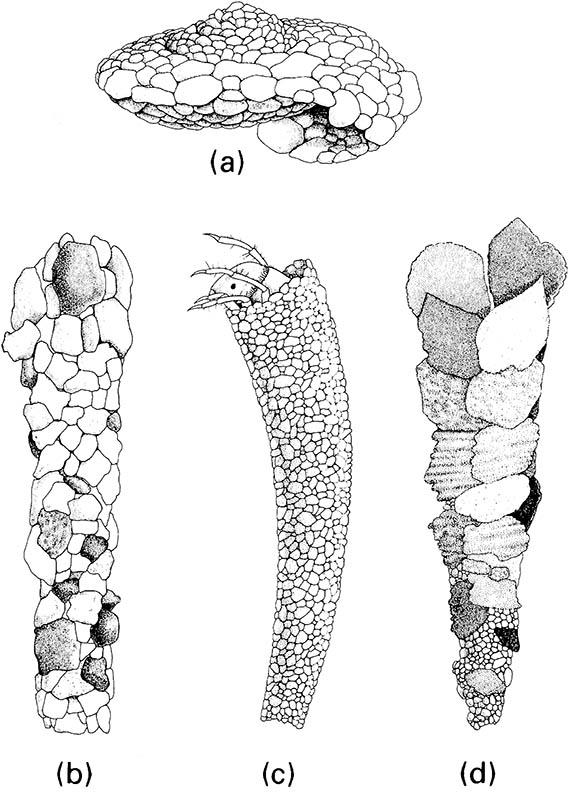14.3. Mechanical defenses
Morphological structures of predatory function, such as the modified mouthparts and spiny legs described in Chapter 13, also may be defensive, especially if a fight ensues. Cuticular horns and spines may be used in deterrence of a predator or in combating rivals for mating, territory, or resources, as in Onthophagus dung beetles (section 5.3). For ectoparasitic insects, which are vulnerable to the actions of the host, body shape and sclerotization provide one line of defense. Fleas are laterally compressed, making these insects difficult to dislodge from host hairs. Biting lice are flattened dorsoventrally, and are narrow and elongate, allowing them to fit between the veins of feathers, secure from preening by the host bird. Furthermore, many ectoparasites have resistant bodies, and the heavily sclerotized cuticle of certain beetles must act as a mechanical antipredator device.
Many insects construct retreats that can deter a predator that fails to recognize the structure as containing anything edible or that is unwilling to eat inorganic material. The cases of caddisfly larvae (Trichoptera), constructed of sand grains, stones, or organic fragments (Fig. 10.6), may have originated in response to the physical environment of flowing water, but certainly have a defensive role. Similarly, a portable case of vegetable material bound with silk is constructed by the terrestrial larvae of bagworms (Lepidoptera: Psychidae). In both caddisflies and psychids, the case serves to protect during pupation. Certain insects construct artificial shields; for example, the larvae of certain chrysomelid beetles decorate themselves with their feces. The larvae of certain lacewings and reduviid bugs cover themselves with lichens and detritus and/or the sucked-out carcasses of their insect prey, which can act as barriers to a predator, and also may disguise themselves from prey (Box 14.2).
The waxes and powders secreted by many hemipterans (such as scale insects, woolly aphids, whiteflies, and fulgorids) may function to entangle the mouthparts of a potential arthropod predator, but also may have a waterproofing role. The larvae of many ladybird beetles (Coccinellidae) are coated with white wax, thus resembling their mealybug prey. This may be a disguise to protect them from ants that tend the mealybugs.
Body structures themselves, such as the scales of moths, caddisflies, and thrips, can protect as they detach readily to allow the escape of a slightly denuded insect from the jaws of a predator, or from the sticky threads of spiders’ webs or the glandular leaves of insectivorous plants such as the sundews. A mechanical defense that seems at first to be maladaptive is autotomy, the shedding of limbs, as demonstrated by stick-insects (Phasmatodea) and perhaps crane flies (Diptera: Tipulidae). The upper part of the phasmatid leg has the trochanter and femur fused, with no muscles running across the joint. A special muscle breaks the leg at a weakened zone in response to a predator grasping the leg. Immature stick-insects and mantids can regenerate lost limbs at molting, and even certain autotomized adults can induce an adult molt at which the limb can regenerate.
Secretions of insects can have a mechanical defensive role, acting as a glue or slime that ensnares predators or parasitoids. Certain cockroaches have a permanent slimy coat on the abdomen that confers protection. Lipid secretions from the cornicles (also called siphunculi) of aphids may gum-up predator mouthparts or small parasitic wasps. Termite soldiers have a variety of secretions available to them in the form of cephalic glandular products, including terpenes that dry on exposure to air to form a resin. In Nasutitermes (Termitidae) the secretion is ejected via the nozzle-like nasus (a pointed snout or rostrum) as a quick-drying fine thread that impairs the movements of a predator such as an ant. This defense counters arthropod predators but is unlikely to deter vertebrates. Mechanical-acting chemicals are only a small selection of the total insect armory that can be mobilized for chemical warfare.

(a) Helicopsychidae; (b) Philorheithridae; (c) and (d) Leptoceridae.

